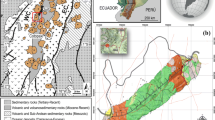Abstract
Drilling, blasting and mechanical methods using road headers or tunnel boring machines (TBMs) are among the methods used for underground excavation of rock and soil. The interaction between the tools used and the ground leads to fragmentation of rocks and soil grains as well as tool wear. Wear is defined as the loss of tool material as a result of the interaction between rocks (or soil) and the drilling tools. The LCPC abrasivity test is a quick and easy procedure used widely to assess the abrasivity of soil and rock for predicting the rate of wear of cutting and drilling tools. The LCPC test device is designed to measure the abrasivity of particles as small as fine gravel. Various parameters can affect the LCPC abrasivity coefficient (LAC). In this paper, equations relating the index properties and the LAC were applied to 27 different samples. The derivation of models predicting the engineering geological properties of rocks and soils is useful because providing specimens of rocks at depth is difficult and expensive in the preliminary design of underground projects. Regression analysis was applied in developing some models for the LAC based on indirect methods including the equivalent quartz content (EQC), grain shape, grain size, grain angularity and water saturation applied to data from rock and soil samples in Iran. The results showed that EQC is the most important parameter affecting the LAC, with the other parameters having lower levels of importance.






Similar content being viewed by others
References
Alavi Gharahbagh EA, Rostami J, Gilbert M (2010) Tool wear issue in soft ground tunnelling, developing a reliable soil abrasivity index. In: Proceedings of the North American Tunnelling Conference, 19–23 June 2010, Portland, OR
Alavi Gharahbagh E, Rostami J, Palomino AM (2011) New soil abrasion testing method for soft ground tunnelling applications. Tunn Undergr Space Technol 26:604–613
Bruland A (1998) PhD thesis. Norwegian University of Science and Technology (NTNU) Trondheim, Norway
Büchi E, Mathier J, Wyss Ch (1995) A significant cost factor for mechanical tunnelling in loose and hard rock. Tunnel 5:38–44
Drucker P (2011) Validity of the LCPC abrasivity coefficient through the example of a recent Danube gravel. Geomech Tunn 4(6):681–691
Düllmann J, Alber M, Plinninger R (2014) Determining soil abrasiveness by use of index tests versus using intrinsic soil parameters. Geomech Tunn 7(1):87–97
Hashemnejad A, Ghafoori M, Lashkaripour G, Tariq Azali S (2012) Effect of geological parameters on soil abrasivity using LCPC machine for predicting LAC. Int J Emerg Technol Adv Eng 2(12):71–76 (ISSN 2250-2459, ISO 9001:2008 Certified Journal)
Käsling H, Thuro K (2010) Determining abrasivity of rock and soil in the laboratory. In: Williams AL, Pinches GM, Chin CY, McMorran TJ, Massey CI (eds) Geologically active. 4600 S., 11th IAEG congress, Auckland, New Zealand, 5–10 September 2010, Paper No. 235, 1973–1980
Köhler M, Maidl U, Martak L (2011) Abrasiveness and tool wear in shield tunnelling in soil (Abrasivität und Werkzeugverschleib beim Schildvortrieb im Lockergestein). Geomech Tunnel 4(1):36–53, Ernst, Berlin
Nilsen B, Dahl F, Holzhäuser J, Raleigh P (2006a) Abrasivity of soils in TBM tunnelling. Tunnels Tunn Int 38(3):36–38
Nilsen B, Dahl F, Holzhäuser J, Raleigh P (2006b) SAT: NTNU’s new soil abrasion test. Tunnels Tunn Int 38(5):43–45
Nilsen B, Dahl F, Holzhäuser J, Raleigh P (2007) New test methodology for estimating the abrasiveness of soils for TBM tunnelling. In: Rapid excavation and tunnelling conference (RETC). Toronto, Canada, pp 104–116
Normalisation Française P18-579 (1990) AFNOR Association Française de Normalisation, Paris
Plinninger RJ (2002) Classification and prognosis of tool wear in conventional excavation in hard rock. Munich geological issues, B18, Technical University of Munich
Plinninger RJ, Restner U (2008) Abrasiveness testing, Quo Vadis? A commented overview of abrasiveness testing methods. Geomech Tunn 1(1):61–70
Rosiwal A (1896) Neue Untersuchungs Ergebnisse über die Härte von Mineralien und Gesteinen. Verhandlg K K Geol R-A Wien, 17:475–491
Rosiwal A (1916) Neuere Ergebnisse der Härte Bestimmung von Mineralien und Gesteinen. Ein absolutes Maß für die Härte Spröder Körper. verhandlg d kk geol R-A Wien, pp 117–147
Tarigh Azali S, Ghafoori M, Lashkaripour G, Hassanpour J (2013) Engineering geological investigations of mechanized tunnelling in soft ground: a case study, East–West lot of line 7, Tehran Metro, Iran. Eng Geol 166:170–185
Tarigh Azali S, Moammeri H (2012) EPB-TBM tunnelling in abrasive ground, Esfahan Metro Line 1. WTC ITA-AITES 2012 World Tunnel Congress, Thailand
Thuro K (1997) Drillability prediction Geological influences in hard rock and blast tunnelling. Geol Rundsch 86:426–437
Thuro K (2002) Geological and Rock mechanical fundamental of excavate ability in tunnelling. Munich Geological Issues, B18, Technical University of Munich
Thuro K, Plinninger RJ (2003) Classification and prognosis of performance and wear parameters in tunnelling. Taschenbuch für den Tunnelbau 2003. Gluckauf, Essen
Thuro K, Singer J, Käsling H, Bauer M (2007) Determining abrasiveness with the LCPC Test. In: Proceedings of the 1st Canada—U.S. rock mechanics symposium, Vancouver
Thuro K, Käsling H (2009) Classification of the abrasiveness of soil and rock. Geomech Tunn 2(2):179–188
Tucker ME (1981) Sedimentary petrology. An introduction. Blackwell, Oxford
Author information
Authors and Affiliations
Corresponding author
Rights and permissions
About this article
Cite this article
Hashemnejad, A., Ghafoori, M. & Azali, S.T. Utilizing water, mineralogy and sedimentary properties to predict LCPC abrasivity coefficient. Bull Eng Geol Environ 75, 841–851 (2016). https://doi.org/10.1007/s10064-015-0779-9
Received:
Accepted:
Published:
Issue Date:
DOI: https://doi.org/10.1007/s10064-015-0779-9




